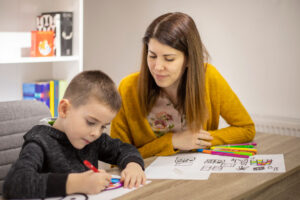5 Rewarding Careers Working with Autistic Children
Despite its prevalence (the CDC reports that about 1 in 54 children are diagnosed with ASD), autism spectrum disorder (ASD) remains elusive and difficult to understand, making its treatment just as challenging. Difficulty with communication and social skills, repetitive behaviors, trouble transitioning from one activity to the next, unpredictable emotions, and aversions to sounds, smells, and textures are just a few of the symptoms exhibited by children and adults with ASD.
But symptoms are rarely the same, making treatment a challenge, in many cases. Just as each child’s personality is unique, so are their ASD symptoms, so working with children with ASD involves plenty of trial and error, patience, and compassion.
Working with autistic children is not for the faint of heart, and daily challenges can be expected.
But don’t let that intimidate you. This is an exceptionally rewarding field, and as many people who have devoted their careers to working with kids with autism will tell you, there’s nothing they’d rather do.
That’s going to mean getting on a career path that frequently involves providing therapeutic, educational and other support services to kids on the spectrum.
So, are you ready to learn how to work with autistic children? There’s no better way than by becoming a special education teacher, occupational therapist, social worker, ASD specialist or SLP.
Is Working with Children with Autism Right For Me?
Working with children with autism is not the right choice for many. In fact, some would say it is reserved only for a special few.
To experience the most success and provide the most effective care to this special demographic, you’ll need to be generous, compassionate, caring, and kind, for sure, but you’ll also need to be patient, tolerant, and even-tempered. A healthy sense of humor to lighten the most difficult of days and an ability to exude an air of calmness in times of crisis or chaos can’t be overstated.
Your intuition will play an important role in any job that involves working with children with autism. What’s working? What isn’t? You’ll likely need to ask yourself these questions throughout the day. A strong connection with the children and a keen appreciation of their needs at any given moment is vital when working with children whose moods and actions can often times be rather unpredictable.
Which brings us to flexibility. You’ll need to perform your job on the fly on many days, so a willingness to go with the flow on those days when things aren’t going exactly as planned is crucial for success when working with children with ASD. Structure is important when working with autistic children, but so is your ability to remain open to exploring different techniques whenever the need arises.
Individuals working with autistic children have a true appreciation for their clients and their unique abilities. Optimism, dedication, and a willingness to brush yourself off after a challenging day and forge ahead with confidence and a caring heart is at the heart of working with children with ASD.
Are you up for this life-changing challenge? Here are some of the top autism careers that give you a chance to work with kids on the spectrum:
Special Education Teacher
 Special education teachers educate children with physical, mental, emotional, and/or learning disabilities in a number of settings, although most work in the PreK-12 environment in a public or private school setting.
Special education teachers educate children with physical, mental, emotional, and/or learning disabilities in a number of settings, although most work in the PreK-12 environment in a public or private school setting.
In the public school setting, they’re state licensed to teach with a special education endorsement, and meet the qualifications by holding a degree in special education that includes a teacher preparation program, along with passing standardized tests. In nearly all settings, they’ll hold, at a minimum, a bachelor’s degree in special education (or a related field like elementary or secondary education with a focus or specialization in special education), although many of these pros also hold master’s degrees in special education and special endorsements or certifications in ASD specifically.
Their work may be performed in a general education classroom, in a self-contained classroom, or in a combination of the two and, depending on their role, they may be qualified to teach children with mild to moderate disabilities or moderate to severe disabilities.
Special education teachers are part of a school team that creates and then follows each student’s Individualized Education Plan (IEP) – a personalized plan of action for educating the child. Special education teachers build lesson plans that cater to their students’ specific needs and modify existing curricula to meet each student’s needs and learning goals.
They also work closely with speech-language pathologists, school counselors, psychologists, psychiatrists, physical therapists, occupational therapists, social workers, and more to ensure coordinated, complete care for the child.
This hands-on position also means managing behavior, resolving conflict, and always exploring ways to engage, motivate, and inspire their students with special needs.
Occupational Therapist
 Occupational therapists helps adults and children reach or regain independence and participate/manage/improve their daily activities related to their emotional, social, and physical needs.
Occupational therapists helps adults and children reach or regain independence and participate/manage/improve their daily activities related to their emotional, social, and physical needs.
Occupational therapy (OT) for children with autism is focused on helping this unique demographic develop and improve learning, playing, and self-care strategies and often includes helping them manage their sensory issues. This may mean helping the child achieve independence with life skills like grooming, bathing, or eating or with fine motor skills like cutting paper or holding a fork. It also includes introducing them to coping strategies to deal with sensitivity to large noises or bright lights.
Occupational therapists first evaluate the child’s ability level by observing how they learn, play, and interact with their environment. The occupational therapist then creates a plan of care that is implemented by them or by occupational therapist assistants during weekly therapy sessions.
As an occupational therapist, you’ll likely spend your days engaging in activities that appeal to the children you’re treating. This may include coloring to help them develop their fine motor skills, tossing a ball to improve their hand-eye coordination, or getting them comfortable with their self-help skills so they feel secure using the toilet or dressing themselves.
You may work in private practices, in schools, in your clients’ homes, or in special sensory gyms that are furnished with items like bean bags, trampolines and swings.
Occupational therapists must hold a master’s degree in occupational therapy, pass a national certification exam, and hold state licensure to practice. In recent years, there has been some debate (and misinformation) on the requirements for licensure for OTs, both now and in the future.
That’s because in August 2017, the Accreditation Council of Occupational Therapy Education (ACOTE) required entry-level occupational therapists to transition to an Occupational Therapy Doctorate by 2027. Under this new rule, individuals who earned their occupational therapy license prior to 2027 would be grandfathered into licensure. However, in 2019, after two years of debate on the issue, the American Occupational Therapy Association (AOTA) and the ACOTE voted to maintain dual entry-level degrees for occupational therapists – called a Dual Point of Entry. Therefore, a master’s degree remains the minimum educational requirement for licensure as an occupational therapist.
Social Assistance – Social Worker
 Social workers play an important role in the care team for children with autism, ensuring children with autism and their families receive the support needed to achieve success in the home, in the classroom, and in the community. Case management, social skills training, and care coordination are just a few of the duties of today’s professionals in social assistance. Their connections within the community make them the obvious choice for connecting children and their families with the services and resources available to them, and they are valuable sources of financial and community support.
Social workers play an important role in the care team for children with autism, ensuring children with autism and their families receive the support needed to achieve success in the home, in the classroom, and in the community. Case management, social skills training, and care coordination are just a few of the duties of today’s professionals in social assistance. Their connections within the community make them the obvious choice for connecting children and their families with the services and resources available to them, and they are valuable sources of financial and community support.
School social workers work with parents, teachers, occupational therapists, physical therapists, and school psychologists to ensure that students with ASD receive the most appropriate services and that care is properly coordinated. They also spend time working directly with ASD students and implement social skills programs in both clinical and school settings.
The services of social workers are particularly significant when children begin to age out of pediatric services and transition to adult vocational services. In the community setting, social workers provide individual and group therapy services, and serve as social-cognitive coaches for adults with ASD.
Social workers specializing in autism work for schools, governmental agencies, and community organizations. In most states, you’ll usually need a Master of Social Work (MSW) and a state license to practice.
Autism Spectrum Disorder Specialist
 Autism spectrum disorder specialists are usually applied behavior analysts who specialize in working with children and adults with autism. Applied behavior analysis (ABA) is a specialty type of therapy that addresses how behavior (how we interact with others through speech, play, and work) is affected by the environment.
Autism spectrum disorder specialists are usually applied behavior analysts who specialize in working with children and adults with autism. Applied behavior analysis (ABA) is a specialty type of therapy that addresses how behavior (how we interact with others through speech, play, and work) is affected by the environment.
Job duties for ABAs working with ASD patients include developing treatment plans that address symptoms of autism. ASD specialists may work in clinics, school, or home settings, where they provide therapies that address speech, sensory, and fine and gross motor skills. ABA therapies are designed to reduce anxiety and stress on the child, decrease negative behaviors, and increase positive behaviors. ASD specialists provide specialized plans of treatment, taking into account each child’s unique needs.
So how do you become an autism specialist? In most cases, you’ll need a master’s degree and specialized training in treating ASD to work in this field.
Speech Language Pathologist
 Speech language pathologists (SLPs) are part of a care team for children with autism that includes medical doctors, neurologists, developmental psychologists, and audiologists. SLPs begin their work with children with ASD by testing their communication (verbal and non-verbal) and social skills and creating a therapy plan. Then, through therapies that work on strengthening these skills, SLPs help their children accomplish any number of goals, such as appropriately communicating with adults and peers.
Speech language pathologists (SLPs) are part of a care team for children with autism that includes medical doctors, neurologists, developmental psychologists, and audiologists. SLPs begin their work with children with ASD by testing their communication (verbal and non-verbal) and social skills and creating a therapy plan. Then, through therapies that work on strengthening these skills, SLPs help their children accomplish any number of goals, such as appropriately communicating with adults and peers.
SLP therapies work on strengthening the muscles of the mouth, jaw and neck, improving the rhythm and rate of speech, improving words and sentences, and understanding both verbal and nonverbal cues.
For nonverbal clients, it also includes the introduction and implementation of alternative augmentative communication (AAC), which includes everything from picture exchange communication systems (PECS) to iPads to speech output devices (Dynavox).
Speech-language pathologists are master’s prepared professionals (with post-bachelor’s work in speech-language pathology) who are state licensed and usually nationally certified through the American Speech-Language-Hearing Association.
Take the first step toward working with ASD children by finding a master’s degree program.





